—-
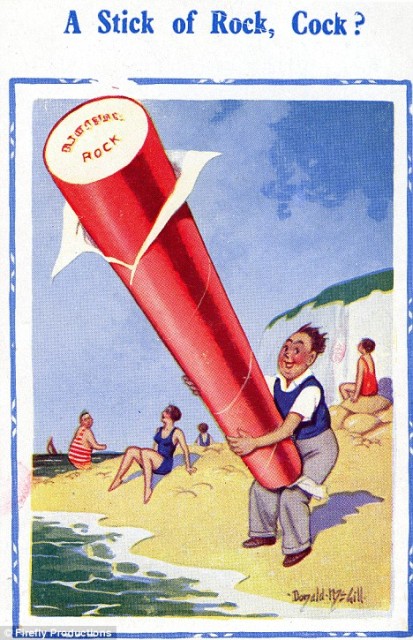
The tradition of the British saucy postcard is marked by a brand of humour that is specific to a time and a place. Its heyday was an era long before any “sexual revolution” came along, predating text messaging and YouTube-embedded emails, a distant time back when bawdy cartoon jokes could be sent home to friends and families, a guilty smutty giggle on the reverse of news from the holiday.
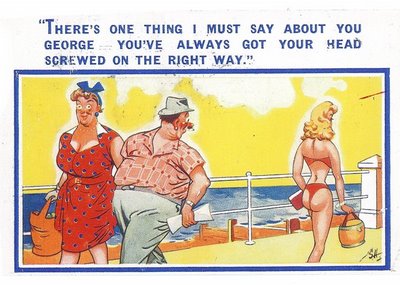

“Saucy Seaside Postcards are a peculiar tradition but are synonymous with holidays along the British coast. They typify the quirky humour of the British which often revolves around sex or bodily functions.
With the English invention of seaside holidays having been popularised by the Victorians, the promenades and piers started to see stalls selling seaside novelties. Seaside postcards with bawdy captions first appeared in the early 20th Century and became extremely popular during the First World War.

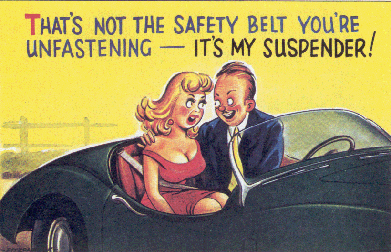
The cards are worth celebrating as a form of folk art that’s now vanished, superseded by changes in technology, in language and in morality. Despite all this the cards evoke a world that remains fascinating to me.
“In the early 1930s, cartoon-style saucy postcards became widespread, and at the peak of their popularity the sale of saucy postcards reached a massive 16 million a year.” —http://en.wikipedia.org/wiki/Postcard

“In today’s liberal world of open frankness on sexual matters, the cartoon characters and antics of the saucy postcard era would hardly lift an eyebrow. However, back in those days of sexual repression, “It” was very much a taboo subject, considered to be the height of bad manners bordering on obscene to discuss. Saucy postcards were a breath of fresh air to some; others were disgusted and offended by them.
The cheeky and often sexually-implied innuendos and double meanings could be either visual or textual, though usually both picture and text played a part. No section of the community was spared; fat people, thin people, mothers-in-law, hen-pecked husbands, waiters and waitresses, lower class, middle class and upper class, glamorous ladies, doctors and nurses, etc, were all represented in cartoon characters. They were often portrayed in risqué, embarrassing or suggestive situations.
The postcards were produced in bright primary colours, and were typically displayed outside seafront gift shops on a traditional revolving postcard stand. Holiday-makers and day-trippers browsing the saucy postcards would often been seen nudging each other and giggling.” —
http://www.bbc.co.uk/dna/h2g2/a4350971

Widely acknowledged as master of this art-form was the English graphic artist Donald McGill.
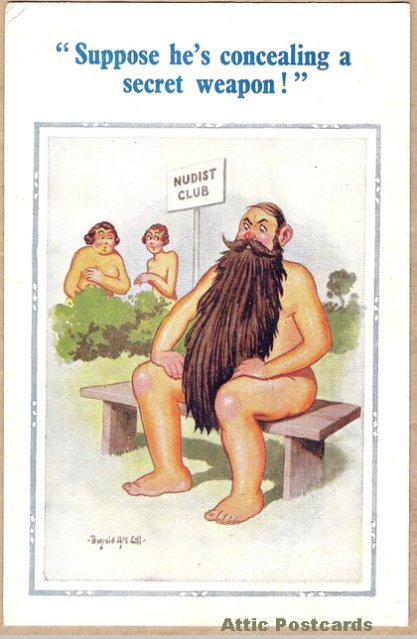
“He has been called ‘the king of the saucy postcard’, and his work is still collected and appreciated for his artistic skill, its power of social observation and earthy sense of humour. Even at the height of his fame he only earned three guineas a design, but today his original artwork can fetch thousands of pounds.
Over the span of his career McGill produced an estimated 12,000 designs, of which 200 million copies are estimated to have been printed… Despite their wide circulation, McGill earned no royalties from his designs; in his will, his estate was valued at just £735.” —
http://en.wikipedia.org/wiki/Donald_McGill
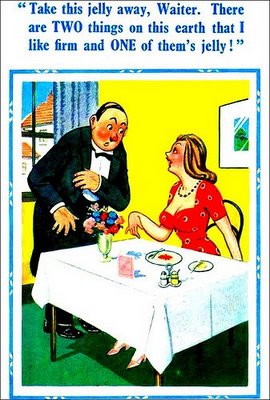
The saucy seaside postcard was the subject of a 1941 essay by George Orwell:
“Your first impression is of overpowering vulgarity. This is quite apart from the ever-present obscenity, and apart also from the hideousness of the colours. They have an utter low-ness of mental atmosphere which comes out not only in the nature of the jokes but, even more, in the grotesque, staring, blatant quality of the drawings. The designs, like those of a child, are full of heavy lines and empty spaces, and all the figures in them, every gesture and attitude, are deliberately ugly, the faces grinning and vacuous, the women monstrously parodied, with bottoms like Hottentots. Your second impression, however, is of indefinable familiarity. What do these things remind you of? What are they so like? In the first place, of course, they remind you of the barely different post cards which you probably gazed at in your childhood. But more than this, what you are really looking at is something as traditional as Greek tragedy, a sort of sub-world of smacked bottoms and scrawny mothers-in-law which is a part of Western European consciousness.”
Orwell would go on to single out McGill’s work for great praise, however:
“I have associated them especially with the name of Donald McGill because he is not only the most prolific and by far the best of contemporary post card artists, but also the most representative, the most perfect in the tradition.” — George Orwell, The Art of Donald McGill
http://www.netcharles.com/orwell/essays/donaldmcgill.htm
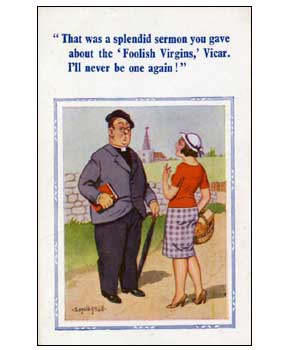
Trailer for a 2005 BBC documentary about McGill:
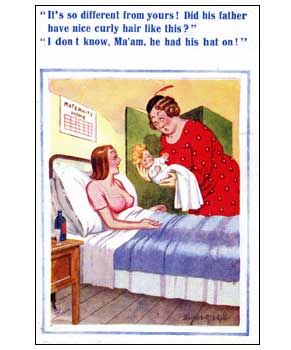
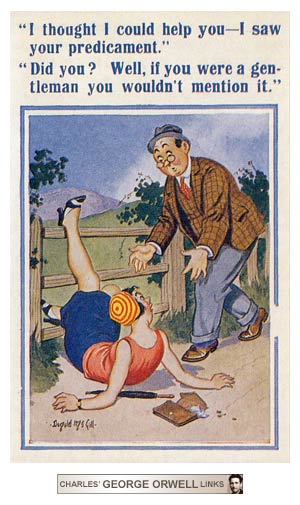
In 1954 he was prosecuted under the Obscene Publications Act of 1857 and pleaded guilty at the Lincoln Quarter Sessions. He was fined £50 with £25 costs, and this link to the UK Social Affairs Unit tells the story.
His eyesight fading, and with demand for his work diminishing, McGill died in 1962 to be buried in an unmarked grave. Since then the art form has slowly but irrevocably been in decline and holidays will never be quite the same again:

“Here, as so often in British life, one gets a sense of something kept artificially alive beyond its natural span, like the pearly kings or the old time music hall. Sixty years ago, you might just have been able to regard the work of Donald McGill and his imitators… as a genuine expression of popular culture. These days anyone who wants a worm’s eye view of contemporary life would probably buy a copy of Viz. What to Orwell was a window on a world has become a well-intentioned marketing exercise.” — DJ Taylor
http://www.guardian.co.uk/theguardian/2001/aug/27/features11.g2
I’ll sign off with this from Orwell’s essay:
“In the past the mood of the comic post card could enter into the central stream of literature, and jokes barely different from McGill’s could casually be uttered between the murders in Shakespeare’s tragedies. That is no longer possible, and a whole category of humour, integral to our literature till 1800 or thereabouts, has dwindled down to these ill-drawn post cards, leading a barely legal existence in cheap stationers’ windows. The corner of the human heart that they speak for might easily manifest itself in worse forms, and I for one should be sorry to see them vanish.”
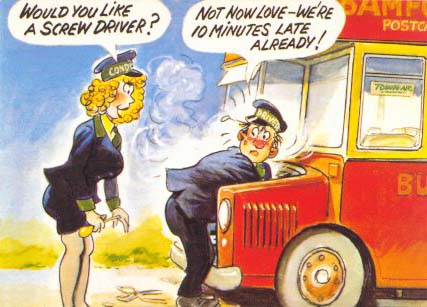
—-
*
p.s. Hey. I’m in Brighton for a showing LIKE CATTLE TOWARDS GLOW today, and you’re here no doubt enjoying the return of this legendary post from _Black_Acrylic.




 Now available in North America
Now available in North America 